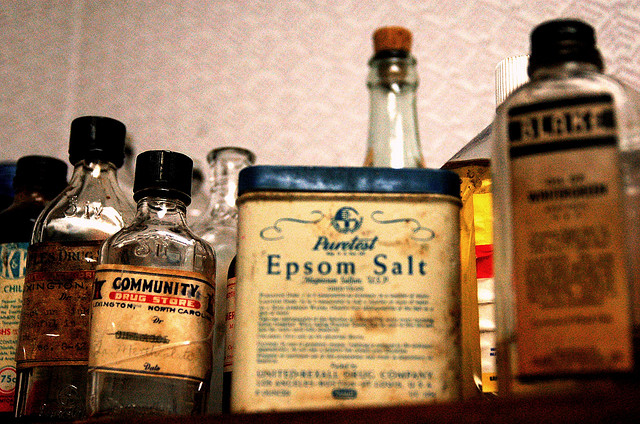Ask Surly Amy: Epsom Salt Soaks

Surly Amy is currently trapped in the cube-like horror under her cousin’s cabin, fighting off either lamprey ballerinas, pain-worshipping redneck zombies, or unicorns. In the meantime, Mary volunteered to answer her mailbag while she is gone. Don’t fret, she’ll be back shortly!
Hi, Amy.
My husband recently developed an ingrown toenail with a pretty gnarly infection. We went to the doctor, and he prescribed antibiotics and "a remedy your Grandma would love" – Epsom salt soaks. As my husband says, his grandma is a great lady, but she's no scientist.
I'm a nurse, and I know that magnesium sulfate is used intravenously to stop premature labor and treat eclampsia. It can be taken internally as a strong laxative or as a supplement for low magnesium levels. The only information I can find on topical use claims that it draws "toxins" out of the body. As a skeptic, my first instinct is to translate "toxins" to "bullshit" but if you know of any information on the medicinal use of topical magnesium sulfate (Epsom salts), I'd love to hear about it.
Skeptic Nurse
Dear Skeptic Nurse,
You’re right to be skeptical whenever you hear the word “toxins.” Doing research on the internet about Epsom Salts is a bit like watching that scene from Idiocracy about electrolytes. (What are Epsom salts? Uh, they’re what muscles/feet crave.) The idea that soaking in a bath with Epsom Salts to draw out toxins seems to be a self-perpetuating myth, because most websites that recommend it as a natural cure usually list no science-based sources. Some of the more “scientific” alternative therapy websites link back to the Epsom Salt Council, whose sole purpose is to promote the usage of Epsom Salts (no conflict of interest there–seems legit to me!).
When people have generic ailments, they soak in Epsom salts and swear the problem is solved. Others who are skeptical because they didn’t notice a difference conclude they must have not added enough Epsom salts to the water. I don’t know the exact logical fallacy that is, so I’m just referring to it as Fucked Up Reasoning.
Since your husband’s doctor prescribed antibiotics, I’m assuming that the soak was suggested to soften the skin around the nail. I am not a medical doctor, but according to my sources (NIH, Mayo Clinic) soaking your feet in warm water is used as a therapy for ingrown toenails to soften up your skin to allow an ingrown toenail to continue growing without getting stuck. The FDA claims that there is no benefit to soaking in salt water vs. regular water and recommends adding some dish soap (with skin softeners) to the foot soak to help with, well, actual skin softening. A Pubmed search yields no published studies on the effects of soaking in warm water with magnesium sulfate. Epsom salts are listed as a drug by the FDA and even though the packaging claims it is beneficial for soaking, the drug facts only indicate its over-the-counter usage as a laxative.
This well-researched article makes a reference to a study (that hasn’t been published yet) that claims soaking in a tub of Epsom salts increases the magnesium levels in blood, which may be beneficial (or may cause Hypermagnesmia). So are Epsom salts mostly harmless in bath water? Not exactly. Soaking in salt water can cause your skin to dry out, and if you already have dry skin this could cause your skin to become more permeable to infections. (This is also why warm water is recommended instead of hot water—same drying effect.)
If you ever have a doctor recommend a magnesium sulfate soak again, ask if there is anything other than anecdotal evidence to prove its efficacy. And always take any advice with a grain of salt.
Got a question you would like some Surly-Skepchick advice on? Send it in! We won’t publish your real name, unless you want us to and creative pseudonyms get bonus points! Just use the contact link on the top left of the page.







I have a vague recollection of my chemistry instructor saying that soaking your feet in Epsom salt worked because it was a hypertonic solution that could … draw water from your cells and reduce swelling I guess? She mostly seemed to know what she was talking about, but I took that with a grain of "salt" (HAH!) because she also claimed that L-lysine made cold sores go away.
I don't have anything peer reviewed to offer in support of the following, but there's two things about Epsom salts that may be helpful
* As mentioned by the previous poster, a solution of magnesium sulfate is seriously hypertonic and will definitely dry out the skin. As Mary mentioned, this is not generally something you want to do. However, in the case of an infection, it helps reduce inflammation, which will reduce pain. And the very article she referenced suggested that it had benefits if the skin was infected.
* It's not well-studied, but magnesium sulfate specifically may help soothe peripheral nerve irritation, further reducing pain. Or maybe that's a side-effect of the hypertonic nature of the solution. The mechanism needs more study, in any case, but it's a mistake to wave off controlled studies of people reporting notable relief from a painful infection such as herpes (which do exist).
I definitely read about its uses with Genital Herpes, but since the writer wanted to know about its use with ingrown toenails I stuck to that. With regards to muscle pain reduction, a warm bath without any salts helps me out. I have added salts to the tub and not noticed a difference.
My chemistry set (back when chemestry sets had Real Chemicals in them) had a bottle of Magnesium Sulfate in it. Hmmm, said my 10 year old self: everybody knows that sulfur heats up and catches fire if you throw it in water, and that magnesium burns really really good. So if you throw something with magnesium AND sulfur into water, it ought to explode and burn…. So I did.
That's how I learned about chemical bonding, lots better than the lame experimets in the instruction book.
Where the results messy and loud?
I wondered about Epsom Salts and how valid their uses are, aside from helping one clean out one's lower GI tract.
On a slightly off topic, my uncle claims salt water is a disinfectent, and that bleach and clorine solutions are just concentrated salt water.
Any help as to whether or not there's truth in that?
Well, he's right that bleach (sodium hypochlorate or NaOCl) is really just a salt in water. But, Chlorine isn't a salt, it's a halogen, and Chlorine is the active (read: disinfecting) agent in bleach. IIRC, it oxidizes the lipid membranes of bacteria, essentailly "popping" and killing them.
Thanks for the reply!
I wondered what it is that allows clorine to disinfect. Curious though how it works on viruses.
Well, from my waiting days (like in waitress) I remember that warm water with a bit of table salt is a blessing for sore feet.
No miracles involved.
But was it the salt or was it just soaking in warm water that helped? I've done both soaks without a noticable difference because warm water is so relaxing anyway.
Soaking in epsom salts, or sea salt, or kosher salt, or expensisive bath salts; invokes memories of time spent on incredible beaches before the Gulf Oil Spill. 'Bittersweet' does not even begin to convey how those memories affect me now.
We are surely talking about a bacterial infection. Wouldn't the hypertonacity cause the bacteria to shrivel like a raisin? And wouldn't the solution tend to penetrate deeper into the wound compared to an anti-bacterial ointment?
Ointments have oil in them so they can usually penetrate into skin better than water. I would assume the hypertonic solution would only kill surface bacteria, in which case it's no better than peroxide.
I agree with Mary. A hypertonic solution might kill off surface bacteria (depending on the concentration), but I can't see it penetrating too deep. Our skin and all its oil is a pretty good barrier to water. I suppose it all depends on the concentration. Too high and you'd dry out your skin, which wouldn't help with the ingrown nail. Too low and you wouldn't really get an effect. Somewhere in the middle, and you… might get sort of a benefit? Given the shaky evidence, I'd say there are better things to use than Epsom salts.
Would it also kill bacteria (and fungi?) that would otherwise (in warm tap water, for example) be spread from elsewhere on the feet into the wound caused by Skeptic Nurse’s husband’s ingrown toe-nail? Feet are notoriously dirty, so unless the person really thoroughly washed their feet with soap and hot water before soaking them, all the germs would spread all over the place. Do the Epsom salts have any effect on this?
Slightly off topic, but in support about what @Charles said about magnesium suppressing peripheral nerve irritation:
Magnesium is about the ONLY thing that will treat Irakandje jellyfish poisoning common in Northern Australia round the Great Barrier reef.
Apparently the pain is so intense you want to die. The mechanism of the neurotoxicity (let alone of treatment) is still very poorly understood.
I would be interested in learning the same information about tea tree oil.
When I was much younger, I had a procedure to remove some plantar warts from my foot. The podiatrist recommended epsom soaks after the procedure for “soothing and antibacterial purposes.” I didn’t question it at the time; I do remember it feeling nice though!
My father and I have one recurring argument about soaking his feet in epsom salts. When he’s done he pours it out on the lawn. Then he blames the dog for the patch of dead grass.
I don’t know about Epsom Salts, but when I get infections in my cuticles (what I get for picking at them and working with my hands), once I’ve lanced it, I soak the finger in a very high salt water solution and it draws the puss out significantly quicker than just straight water. Now, I’m just using a bunch of table salt in a glass here, but I wonder if the doctor isn’t going for the same effect? Would require opening the wound though.
(and yes, after soaking I apply antibiotic cream and a bandage)
The one time I’ve been told to use Epsom salts was similar to Ainuvande’s experience– at the age of 11, I had an infected cut in the side of my foot. (Jumping off a dock into a none-too-clean bayou and hitting my foot on a sharp rock– ah, childhood.) In addition to antibiotic cream, bandages, and a tetanus booster, I soaked my foot in warm water with Epsom salts to draw out the pus. I don’t know if it worked any faster than plain warm water would have, but I do remember being surprised by the fascinating-yet-gross results.
(Though the main thing I remember is that it was summer and I didn’t want to be stuck in a bathroom soaking my foot every day, so my mom put the salt water in a bucket that I could carry around, allowing me to spend time outside. Also, the annoyance of not being allowed to swim in Lake Michigan while the cut healed.)
Could it be that the salts are used as an abrasive so while you swish your foot around a bit (I do to get the water to feel warm again), it sloughs off a bit of the dead skin. It would be helpful for ingrown nails because it gently takes off some from the area the nail is caught on. However, I doubt it’s any more effective than just scraping your nail around the area after soaking in regular warm water.
I recently had a partial nail resection done on a big toe. Post op instructions included twice daily soaking in warm water Epson salts, to help draw out dead tissue. I believe the purpose of the Epsom salt is to help soften the skin, which it does.
Epsom salt feels nice in a bath or hot tub. Oddly, it also prevents the skin on your fingers from wrinkling while being soaked.
For one group of the population, Epsom Salt baths are an essential supplement to aid detoxification. The majority of those with autism have critically low serum sulphate levels, and without adequate sulphate, the enzyme phenol sulphur transferase cannot correctly metabolise phenolic compounds such as salicylates found in most fruit, vegetables and spices. Un-metabolised they can cause a number of physical and psychological symptoms. https://www.facebook.com/Paul.Jorgesson/posts/1621558314787832